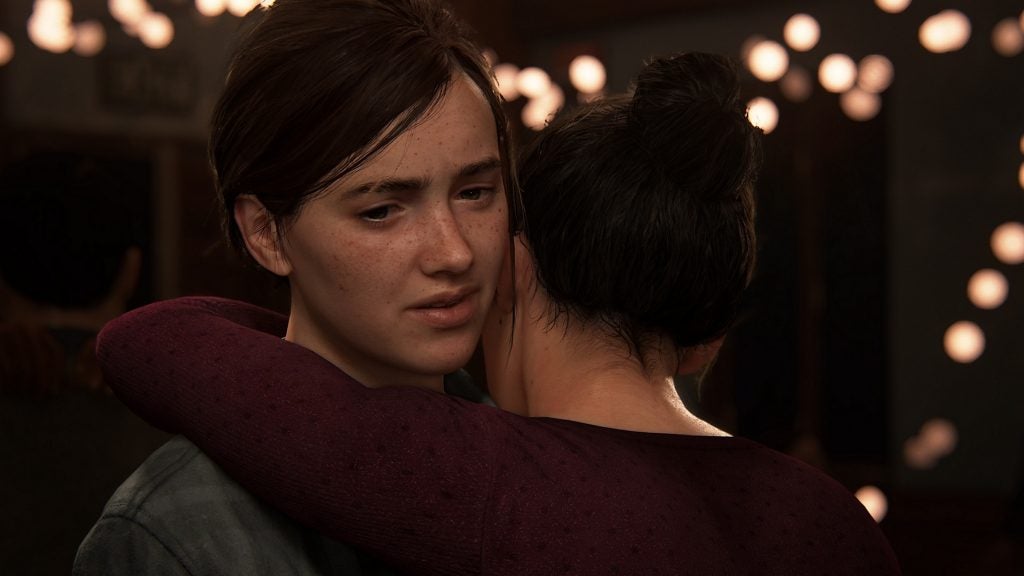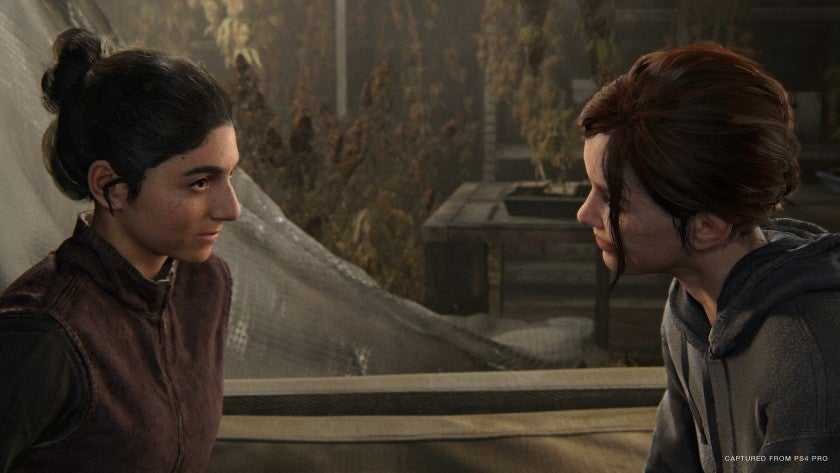How The Last of Us 2 redefines LGBT storytelling in gaming

Spoiler Warning: This piece includes spoilers relating to the game’s plot. If you want a spoiler-free breakdown of the game check out our The Last of Us 2 review.
During the early hours of The Last of Us 2, Ellie and Dina stumble into a queer bookshop. The walls are adorned with pride flags while gay, lesbian and transgender literature litters the shelves, a bitter reminder of the inclusive progress this world was making before the apocalypse brought everything to a halt. They ask themselves loudly, “what’s with all the flags,” clueless about what such identities meant and stood for before their existence was defined by little more than a desperate need for survival.
It’s a sweet, touching moment as these two young women point at an erotic novel displayed before them, jokingly saying “it’s us” while Ellie picks it up and nervously peruses through the pages. It’s a casual observation from two people in love, and their gender has absolutely no bearing on that fact. When the world as we know it ceased to exist, many of its prejudices went along with it, allowing queer identities to flourish in The Last of Us 2 with refreshing liberty. Naughty Dog uses this knowledge to craft a truly inclusive blockbuster, pushing boundaries in a way I’ve rarely seen this medium accomplish before.
Related: Best PS4 Games

You’ll find more comprehensive efforts in the indie space with an abundance of games screaming from the queer rooftops, but the world of blockbusters has often avoided such storytelling, or pushed it into the periphery. The Outer Worlds, Life is Strange and Night in the Woods are just a few mainstream examples I can think of. These efforts walked so The Last of Us 2 could run, and that’s exactly what it does.
Ellie’s identity as a lesbian stands at the forefront of Naughty Dog’s sequel. Her relationship with Dina is passionate, troubled and wrought with intricacies that lend it a sense of authenticity that reflects reality. Regardless of your sexual orientation, romantic relationships are oftentimes messy, with couples having to work together to find happiness despite their differences. Loved ones aren’t perfectly fitting puzzle pieces, especially when you’ve got an apocalypse to deal with on top of everything else.
Seeing these two women interact, bicker and draw closer to their common goal while supporting one another is genuinely heartfelt, while you can feel yourself growing weary as an eventual rift of division emerges between them. Ellie’s drive for revenge becomes irrational, putting both herself and those she cares for in danger in favour of an endgame that, in my eyes, simply wasn’t worth it. You’ll draw your own conclusions, but seeing this couple inadvertently tear themselves apart only to end up back in each other’s arms is a real heartbreaker, and you can do nothing but sit back and watch.
Related: Ghosts of Tsushima

While the game’s marketing materials may have led you to believe this is Ellie’s adventure alone, it’s only half the story. During the second half you’ll take control of Abby, playing through events from a new perspective to gain a greater understanding of her plight, motivations and reasons for acting as she does. Much like Ellie, she’s driven by a thirst for vengeance. But unlike Ellie, she comes to realise her vengeance isn’t worth the loss of life it will entail.
She’s also a new component to The Last of Us 2’s wider ambitions for queer storytelling. During her campaign, Abby is captured by a murderous christian cult known as The Seraphites. This twisted sect shuns the old world, opting for more traditional means of living in both the technology they use and the roles their members are assigned at a young age. Men will traditionally be cast as soldiers or hunters, while women can be forced to stay at home as obedient wives who tend the homestead and produce children.
This is where Lev and Yara come into play – two members of the cult who find themselves primed for execution after betraying firmly held beliefs. The only way to repent for your sins is to “be made pure,” which sadly involves being hung before your stomach is sliced open, letting your entrails pool onto the ground below. Lev and Yara save Abby’s life at the last possible moment, and together they escape and manage to salvage a few brief moments of safety.
Related: Best PS5 Games

From here, the tumultuous circumstances of Lev and Yara begin to unravel. Badly wounded, Yara requires medical attention that can only be found by placing immense trust in Abby, crossing cultural boundaries that will see them form new allies as the place they once called home has left them behind. It’s a fascinating dynamic, establishing a dichotomous relationship of clashing ideals which are eventually pushed aside in favour of one prevailing constant – love. It’s the thing that ties The Last of Us 2 together, even amidst the constant torrents of bloodshed.
But let’s stop beating around the bush and finally establish why Lev and Yara are so groundbreaking in their depiction, showing that queer identities in mainstream media needn’t be cynical ticks on a diversity quota. Lev is a transgender man, and that is stated explicitly and without any doubt on the game’s part. The player’s interpretation is forfeit, with Lev’s identity acting as a driving force behind his banishment from The Seraphites and pursuit of a new life.
In an act of defiance against the role he has been assigned and a continuing struggle with his gender identity, Lev shaves his head to show The Seraphites that he is a man, and wishes to abandon the feminine ideals he’s been straddled with for so many years. It’s a watershed moment for transgender representation in the AAA space, even though it isn’t perfect.
Lev is deadnamed (addressed as their previous name and gender) for plot purposes and his life is torn apart because the burden of hiding who they are simply became too much. As a transgender woman, I’ve had old friends and family members express issues with my identity, failing to realise that this is who I’ve been since I was born, I just wasn’t in a position to figure that out until the time was right, and hiding in the closet was my only option. The Last of Us 2 mirrors this dilemma, except our characters also have a viral apocalypse and homicidal cults to deal with on top of everything else.
Related: PS5 vs Xbox Series X

Outside of the cult, Lev finds an immediately welcoming support network in the arms of Abby and Yara. His identity is never questioned or mulled over as an overly scrutinised narrative touchstone. It’s just who he is and that’s accepted without a second thought. It’s refreshing to see a trans character whose “transness” isn’t the defining trait of their existence, even if we’re still forced to watch them suffer at the hands of abusers.
Naughty Dog is no stranger to introducing queer characters and subjecting them to immediate doom, doing exactly that in The Last of Us: Left Behind. It saw the reveal of Ellie’s sexuality moments before her romantic interest is killed, with our heroine being forced to watch as Riley succumbs to the infection and she comes to terms with her own immunity. It’s emotionally wrenching, and a sadly typical example of minority voices being subject to misery purely because cis-voices fail to show representation in any other way.
Lev isn’t immune from this tiresome trope, although thankfully rises above it as we spend more and more time with him. Their interpretation of the world is defined by the cult, and working alongside Abby allows Lev to grow into someone far more independent and forward-thinking. He shows no qualms with fighting back against his past comrades, juxtaposed with Abby finding herself in the exact same predicament. Misery loves company, and The Last of Us 2 emphasises that close relationships can form in the most unlikely of circumstances.
Related: The Last of Us 2 – Tips and Tricks

It’s somewhat ironic that prejudices that dominate our own modern zeitgeist are things of the past in Naughty Dog’s world, only an issue for those who cling to archaic definitions of faith as an irrational drive for survival. The only visible examples of homophobia or transphobia in The Last of Us 2 come from generations who grew up before the pandemic, absorbed by a cultural discourse where LGBT people were demonised for simply existing.
There’s an aura of ignorant bliss when Ellie and Dina stumble into that bookshop, unaware of the significance such iconography bears on the identities they have naturally assumed, simply because it’s normality. It’s a beautiful outlook despite the harrowing circumstances they find themselves in. Everyday they’re fighting for survival against other humans and deadly infected, but they’re never having to defend who they are, because those attitudes aren’t ingrained in their thinking like a lingering parasite.
After escaping from The Seraphites, Lev begins to embrace a world without prejudice, growing closer to Abby and taking inspiration from her passionate, welcoming attitude that is a perfect signature to The Last of Us 2’s beautifully inclusive nature. I have issues with the ways in which it addresses its cyclical themes of violence and the demonisation of queer individuals, but it’s all in service of a message that champions love, hope and admiration above all else.
Naughty Dog’s presentation of lesbian, bisexual and transgender identities isn’t perfect, partly because of small mistakes and a realistic, messy portrayal of how such people would exist in a world torn asunder. Flaws aside, it champions queer voices in a way no game of this calibre has done before, and The Last of Us 2 isn’t afraid to silence the bigoted minority who stand against them.
As The Last of Us 2’s heroes taught us “endure and survive” and be true to yourself doing it.


